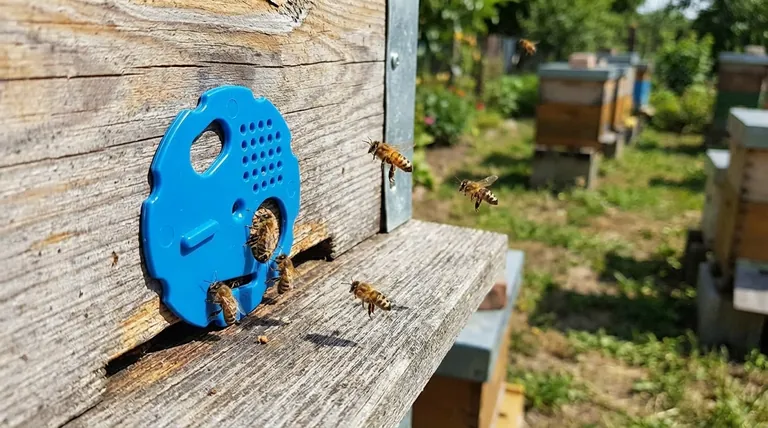In short, an entrance reducer is a critical tool for hive management. Its primary benefits are to shrink the hive's entrance, making it easier for a small or developing colony to defend against robbers and pests. It also helps the bees regulate internal temperature and conserve heat, which is vital for survival and growth.
The core function of an entrance reducer is not merely to block an opening, but to strategically manage a colony's vulnerability. It gives smaller, weaker, or overwintering hives a significant advantage by reducing the physical space they must control.

The Primary Role: Defending the Colony
A beehive's entrance is its most vulnerable point. A large, undefended opening is an invitation for intruders that can quickly overwhelm a colony.
A Smaller Front Door
A smaller entrance requires fewer guard bees to patrol effectively. This allows a new or small colony to allocate more of its population to essential internal tasks like nursing brood and building comb.
Preventing Robbing
Stronger, more populous hives in the area may attempt to "rob" the honey stores of a weaker hive. A reduced entrance creates a chokepoint, making it much easier for the home colony to repel these attacks.
Climate Control and Hive Stability
Bees expend enormous energy maintaining the hive's internal temperature and humidity. An entrance reducer plays a crucial role in making their job easier.
Conserving Heat
In cooler weather or during the critical brood-rearing phase, a smaller opening dramatically reduces heat loss. This allows the cluster to stay warm without consuming excessive honey stores.
Managing Airflow
While it seems counterintuitive, a reducer helps the bees manage ventilation more effectively. It prevents strong drafts that can chill the brood nest while still allowing the bees to create the airflow they need.
A Critical Barrier Against Pests
An unprotected hive entrance is an open door for a variety of pests and predators that can cause significant damage.
Blocking Mice
During fall and winter, mice often seek warmth and food inside beehives. A standard entrance reducer is specifically sized to block mice while allowing bees to pass, which can prevent the complete destruction of a dormant colony.
Discouraging Other Pests
The smaller opening also helps the colony guard against intrusions from other insects like wasps and hornets, which prey on bees and their larvae.
Understanding the Trade-offs
Using an entrance reducer is not a "set and forget" solution. Mismanagement can create new problems for the colony.
Risk of Overheating
During hot weather and strong nectar flows, a reduced entrance can hinder ventilation. This can lead to overheating and cause bees to "beard" on the outside of the hive instead of working.
Potential for Traffic Jams
A strong, populous colony has thousands of foragers coming and going. A small opening can create a bottleneck, reducing the efficiency of foraging operations.
The Need for Regular Cleaning
A small opening can become clogged by debris or dead bees. It is essential to check the entrance regularly to ensure it remains clear, as a complete blockage can be fatal to the colony.
When to Use an Entrance Reducer
The decision to use a reducer, and which size opening to select, depends entirely on the colony's current condition and the time of year.
- If you are installing a new colony: Use the smallest opening to give the bees maximum defensive advantage while they establish themselves.
- If your colony is weak or small: Keep a reducer in place to protect them from robbing and help them conserve energy as they build up their population.
- If you are preparing for winter: Use a reducer to prevent mice from entering and to help the cluster retain heat.
- If your hive is strong and nectar is flowing: Remove the reducer completely to maximize ventilation and prevent a foraging bottleneck.
Properly using an entrance reducer is one of the simplest and most effective ways to support your colony’s health and long-term success.
Summary Table:
| Benefit | Key Function |
|---|---|
| Enhanced Defense | Creates a chokepoint, making it easier for guard bees to repel robbers and pests. |
| Improved Climate Control | Reduces heat loss in cool weather and helps bees manage internal temperature. |
| Pest Barrier | Blocks mice and deters other insects like wasps from entering the hive. |
| Energy Conservation | Allows a smaller colony to allocate more bees to brood rearing and comb building. |
Equip your apiary for success with HONESTBEE.
Proper hive management starts with the right equipment. As a trusted wholesale supplier for commercial apiaries and beekeeping equipment distributors, HONESTBEE provides durable, effective entrance reducers and other essential supplies to support strong, productive colonies.
Let us help you build a more resilient and profitable operation. Contact our team today to discuss your wholesale needs and discover the HONESTBEE advantage.
Visual Guide

Related Products
- Multi-Functional Rotary Hive Entrance Disc for Beekeeping
- Multi-Functional Sliding Hive Entrance for Beekeeping
- Beehive Entrance Discs Plastic Bee Entrance Disc for Bee Hives
- HONESTBEE Advanced Ergonomic Stainless Steel Hive Tool for Beekeeping
- Professional Insulated Winter Hive Wrap for Beekeeping
People Also Ask
- What are the four entrance options provided by the steel entrance disc? Master Hive Traffic & Protection
- What is the purpose of the steel entrance disc? Master Hive Traffic Control & Security
- What does a fully open setting on a round beehive entrance disc allow? Maximize Foraging & Ventilation
- What are the adjustable functions of the circular metal beehive entrance disc? Master Hive Access Control
- What does a fully closed setting on a round beehive entrance disc indicate? A Guide to Hive Security



















